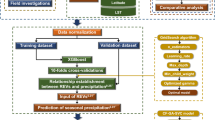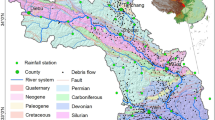Abstract
Debris flow is commonly initiated by torrential rain and its triggering is correlated to the hydrological, geological, and geomorphic conditions on site. In spite of the important effects of geology and topography, rainfall characteristic is the main external triggering factor to debris flow and is a predominant parameter for real-time monitoring. Due to the scarcity of sufficient spatial ground-based rainfall data in hill areas, quantitative precipitation estimation using remote-sensing techniques such as radar and satellite is needed for debris flow pre-warning. The QPESUMS (Quantitative Precipitation Estimation and Segregation Using Multiple Sensors) system was acquired to retrieve spatial rainfall data during the rainfall period from June 30 to July 6 in 2004 when Typhoon Mindulle and southwesterly flow struck Taiwan. The retrieved data were used for setting up the debris flow monitoring algorithm. With the aid of multiple platforms of meteorological observations, a rainfall threshold isohyet in a pilot area was mapped for debris flow monitoring. The rainfall monitoring algorithm based on QPESUMS provides more detailed information than the limited number of ground-based rainfall stations for interpreting the spatial distributions of rainfall events, and therefore is more suitable for debris-flow monitoring.
Similar content being viewed by others
References
Caine N (1980) The rainfall intensity-duration control of shallow landslides and debris flow. Geografiska Annaler 62:23–27
Cannon SH, Ellen SD (1985) Rainfall conditions for abundant debris avalanches in San Francisco Bay California. California Geol 38:267–272
Chen CY, Chen TC, Yu FC, Yu WH (2005) Rainfall duration and debris-flow initiated studies for real-time monitoring. Environ Geol 47:715–724
Crosta G, Frattini P (2002) Rainfall thresholds for triggering soil slips and debris flow, Proceedings of 2nd Plinius International Conference on Mediterranean Storms, Siena, Italy
Johnson D, Smith M, Koren V, Finnerty B (1999) Comparing mean areal precipitation estimates from NEXRAD and rain gauge networks. J. Hydrologic Eng. 4:117–124
Keefer DK, Wilson RC, Mark RK, Brab EE, Brown WM, Ellen SD, Harp EL, Wieczorek GF, Alger CS, Zatkin RS (1987) Real-time landslide warning during heavy rainfall. Science 238:921–925
Lee CS, Huang LR, Shen HS, Wang ST (2006) A climatology model for forecasting typhoon rainfall in Taiwan. Natural Hazards 37:87–105
Takahashi T (1981) Debris flow. Ann Rev Fluid Mech 13:57–77
Vieux BE, Vieux JE, Chen CR, Howard KW (2003) Operational deployment of a physics-based distributed rainfall-runoff model for flood forecasting in Taiwan. IAHS General Assembly at Sapporo, Japan, July 3–11
Wieczorek GF (1987) Effect of rainfall intensity and duration of on debris flows in Central Santa Cruz Mountains. California, flows/ avalanches: process, recognition, and mitigation, Geological Society of America. Rev Eng Geol 7:93–104
Wilson RC, Jayko AS (1997) Preliminary maps showing rainfall thresholds for debris-flow activity, San Francisco Bay region, California. OPEN-FILE REPORT 97–745 F, US Geological Survey
Xie H, Zhou X, Vivoni ER, Hendrickx JMH, Small EE (2005) GIS-based NEXRAD stage III precipitation database: automated approaches for data processing and visualization. Comput Geosci 31: 65–76
Yates DN, Warner TT, Leavesley GH (2000) Prediction of a flash flood in complex terrain. Part II: A comparison of flood discharge simulations using rainfall input from radar, a dynamic model, and an automated algorithmic system. J Appl Meteorol 39:815–825
Young CB, Bradley AA, Krajewski WF, Kruger A, Morrissey ML (2000) Evaluating NEXRAD multisensor precipitation estimates for operational hydrologic forecasting. J Hydrometeorol 1:241–254
Acknowledgements
The material in Table 1 is obtained from the Soil & Water Conservation Bureau and from an unpublished document: Liao J. J., Dong J. J., Lin M. L., and Jeng F. S.: 2004, Suggestions of rehabilitated strategy for Puwu expressway and Nanfeng village (in Chinese).
Author information
Authors and Affiliations
Corresponding author
Rights and permissions
About this article
Cite this article
Chen, CY., Lin, LY., Yu, FC. et al. Improving debris flow monitoring in Taiwan by using high-resolution rainfall products from QPESUMS. Nat Hazards 40, 447–461 (2007). https://doi.org/10.1007/s11069-006-9004-2
Received:
Accepted:
Published:
Issue Date:
DOI: https://doi.org/10.1007/s11069-006-9004-2




